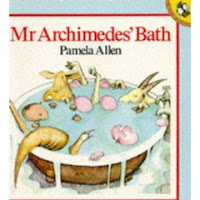1. Teaching how to count
Some books and early children's rhymes actually try to teach children how to count; introducing them to the concept of counting and demonstrating it through words, pictures and sometimes actions.
 a) Traditional rhymes - Some children have some of their earliest encounters with counting as their parents teach them number rhymes, chants or poems. Fingers are an essential prop. For example:
a) Traditional rhymes - Some children have some of their earliest encounters with counting as their parents teach them number rhymes, chants or poems. Fingers are an essential prop. For example:5 Little ducks went out one day.....
Sing a Song of Sixpence...
This little pig went to market...
You can find hundreds of traditional rhymes here
 b) Books that teach counting - Some books try to do the same thing through words and pictures. For example, 'One Duck, Another Duck' by Charlotte Pomeranz (1984). In this delightful book Danny the owl is taken by his grandmother to the pond and she teaches him to count the ducks:
b) Books that teach counting - Some books try to do the same thing through words and pictures. For example, 'One Duck, Another Duck' by Charlotte Pomeranz (1984). In this delightful book Danny the owl is taken by his grandmother to the pond and she teaches him to count the ducks:Danny started to count them. "One duck, another duck, another duck, another duck..." 'No', said grandmother. 'You know how to count. One, two, three and so on. Count them again."
2. Counting books
Many books simply aim to teach children to count from 1 to 10, or 1 to 20. There are countless examples, all of which introduce children to rich language and teach concepts of print while at the same time teaching children to count. For example:
 a) One fish, two fish, red fish, blue fish, by Dr Seuss (1960) teaches some basic maths while introducing children to many other concepts, new vocabulary (e.g.colours) and how rhyme works.
a) One fish, two fish, red fish, blue fish, by Dr Seuss (1960) teaches some basic maths while introducing children to many other concepts, new vocabulary (e.g.colours) and how rhyme works.b) One woolly wombat, by Kerry Argent (1982) teaches children to count to fourteen while enriching their language:
One woolly wombat sunning by the sea
Two cuddly koalas sipping gumnut tea
Three warbling magpies waking up the sun etc
 c) Waterhole, by Graeme Base (2001) again teaches counting through rich rhyme, language and incredible drawings that invite the reader to find the animals on each page and count them. This is all embedded within a simple narrative that tells the story of a waterhole and the animals that use it and what happens as it slowly dries up before finally being replenished by rain. Graeme Base is a master at including mathematical concepts and puzzles within his work.
c) Waterhole, by Graeme Base (2001) again teaches counting through rich rhyme, language and incredible drawings that invite the reader to find the animals on each page and count them. This is all embedded within a simple narrative that tells the story of a waterhole and the animals that use it and what happens as it slowly dries up before finally being replenished by rain. Graeme Base is a master at including mathematical concepts and puzzles within his work.3. More advanced mathematical and scientific concepts
Some children's picture books are even more ambitious and attempt to teach advanced mathematical and scientific concepts.
a) Counting on Frank, by Rod Clement (1990) introduces children to estimation as a smart (nerdy) and amusing boy (Frank) speculates about many things. How many dogs identical to his own would it take to fill his room? How many of his Dad could he squeeze into a television? How long it would take to fill his entire bathroom at bath time?
 b) Mr Archimedes Bath, by Pamela Allen (1983) tells the story of how Mr Archimedes and his friends solve the problem of water displacement. Why does the bath overflow when they all climb in? Allen plays with the same concept in 'Who sank the boat' (1982)
b) Mr Archimedes Bath, by Pamela Allen (1983) tells the story of how Mr Archimedes and his friends solve the problem of water displacement. Why does the bath overflow when they all climb in? Allen plays with the same concept in 'Who sank the boat' (1982)c) The Eleventh Hour: A Curious Mystery, by Graeme Base (1988) - this brilliant book explores the concept of time while also encouraging readers to solve a variety of mathematical puzzles. All this is woven within a tale about an elephant that turned 11 years old.
I've only tried to offer a small sample of literature that teaches about mathematics; there are many other examples. Why don't you read some books on 'World Mathematics Day' to your two year-old in preparation for World Mathematics Day 2012!
Related Post
I wrote an earlier post on the many things that children learn from literature, it may be of interest (click here).
1 comment:
I love Counting on Frank. For me, with a science-y mind, I think it is great! Such wonderful curiosity.
Post a Comment